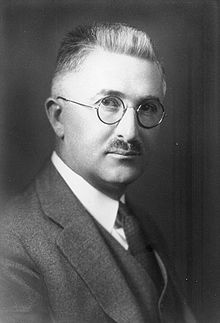Ralph Hartley
Ralph Hartley | |
|---|---|
 | |
| Born | November 30, 1888 |
| Died | May 1, 1970 (aged 81) |
| Nationality | American |
| Alma mater | University of Utah Oxford University |
| Awards | IEEE Medal of Honor |
| Scientific career | |
| Fields | Electrical engineering |
Ralph Vinton Lyon Hartley (November 30, 1888 – May 1, 1970) was an electronics researcher. He invented the Hartley oscillator and the Hartley transform, and contributed to the foundations of information theory.
Biography
Hartley was born in Spruce, Nevada, USA and attended the University of Utah, receiving an A.B. degree in 1909. He became a Rhodes Scholar at St Johns, Oxford University, in 1910 and received a B.A. degree in 1912 and a B.Sc. degree in 1913. He married Florence Vail of Brooklyn on March 21, 1916.[1]
He returned to the United States and was employed at the Research Laboratory of the Western Electric Company. In 1915 he was in charge of radio receiver development for the Bell System transatlantic radiotelephone tests. For this he developed the Hartley oscillator and also a neutralizing circuit to eliminate triode singing resulting from internal coupling. A patent for the oscillator was filed on June 1, 1915 and awarded on October 26, 1920.
During World War I he established the principles that led to sound-type directional finders.
Following the war he returned to Western Electric. He later worked at Bell Laboratories. He performed research on repeaters and voice and carrier transmission and formulated the law "that the total amount of information that can be transmitted is proportional to frequency range transmitted and the time of the transmission." After about 10 years of illness he returned to Bell Labs in 1939 as a consultant.
During World War II he was particularly involved with servomechanism problems.
He retired from Bell Labs in 1950 and died on May 1, 1970.
Awards
- IRE Medal of Honor, 1946, for his oscillator and information proportionality law. This was an award from the Institute of Radio Engineers which later merged into the Institute of Electrical and Electronics Engineers; the award became the IEEE Medal of Honor.
- Fellow of the American Association for the Advancement of Science
Publications
Probably incomplete.
- Hartley, R.V.L., "Transmission of Information", Bell System Technical Journal, July 1928, pp.535–563.
- Hartley, R.V.L., "A More Symmetrical Fourier Analysis Applied to Transmission Problems," Proceedings of the IRE 30, pp.144–150 (1942).
- Hartley, R.V.L., "A New System of Logarithmic Units", Proceedings of the IRE, January 1955, Vol. 43, No. 1.
- Hartley, R.V.L., "Information Theory of The Fourier Analysis and Wave Mechanics", August 10, 1955, publication information unknown.
- Hartley, R.V.L., "The Mechanism of Gravitation", January 11, 1956, publication information unknown.
- Hartley, R.V.L., "A Wave Mechanism of Quantum Phenomena", Physical Review, Volume 33, Page 289, 1929 (abstract only)
- Hartley, R.V.L., "Oscillations in Systems with Non-Linear Reactance", The Bell System Technical Journal, Volume 15, Number 3, July 1936, pp 424 - 440
See also
References
- ^ Frank Aydelotte (1916). The American Oxonian. Association of American Rhodes Scholars. p. 84.
- Ralph V. L. Hartley, Legacies, IEEE History Center, updated January 23 2003, [1]
- US Patent 1,356,763, Oscillation Generator, October 26, 1920, United States Patent and Trademark Office, [2]; page images can be downloaded.
- US Patent 1,666,206, Modulation System, April 17, 1928, United States Patent and Trademark Office, [3]; page images can be downloaded.
